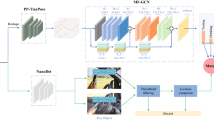Abstract
Real-time detection and identification of dangerous driving behaviors is an effective measure to reduce traffic accidents. Due to the high network delay, limited communication bandwidth, and weak computing power, lightweight detection models that can run on edge devices have been widely investigated and attracted considerable attention. In recent years, the Graph Convolutional Network (GCN), which models the human skeleton as a spatiotemporal graph, has achieved remarkable performance, due to its powerful capability of modeling non-Euclidean structure data. However, there are disadvantages such as the single way of extracting information, high model complexity, and inability to integrate environmental information. Therefore, we propose a lightweight dangerous driving behavior detection model based on GCN. First, two local information extraction modules are designed to extract skeleton information features. Meanwhile, we propose a multi-information fusion behavior recognition model of “people \( {+} \) objects” by capturing the motion information of related object. Finally, the method based on Singular Value Decomposition (SVD) rank reduction is used to compress the model to improve the speed of recognizing an action sample under sufficient detection accuracy. The proposed model respectively achieves 96% and 86.3% accuracy on the x-view benchmark of NTU-RGBD dataset and the homemade Locomotive Driver Dataset, which attains the state-of-the-art performance.
Access this chapter
Tax calculation will be finalised at checkout
Purchases are for personal use only
Similar content being viewed by others
References
Cho, S., Maqbool, M., Liu, F., Foroosh, H.: Self-attention network for skeleton-based human action recognition. In: Proceedings of the IEEE/CVF Winter Conference on Applications of Computer Vision, pp. 635–644 (2020)
Giles, M.: An extended collection of matrix derivative results for forward and reverse mode automatic differentiation (2008)
Idelbayev, Y., Carreira-Perpinán, M.A.: Low-rank compression of neural nets: learning the rank of each layer. In: Proceedings of the IEEE/CVF Conference on Computer Vision and Pattern Recognition, pp. 8049–8059 (2020)
Jaderberg, M., Vedaldi, A., Zisserman, A.: Speeding up convolutional neural networks with low rank expansions. arXiv preprint arXiv:1405.3866 (2014)
Ke, Q., Bennamoun, M., An, S., Sohel, F., Boussaid, F.: A new representation of skeleton sequences for 3D action recognition. In: Proceedings of the IEEE conference on computer vision and pattern recognition, pp. 3288–3297 (2017)
Krishnan, D., Tay, T., Fergus, R.: Blind deconvolution using a normalized sparsity measure. In: CVPR 2011, pp. 233–240. IEEE (2011)
Li, C., Xie, C., Zhang, B., Han, J., Zhen, X., Chen, J.: Memory attention networks for skeleton-based action recognition. IEEE Transactions on Neural Networks and Learning Systems (2021)
Shahroudy, A., Liu, J., Ng, T.T., Wang, G.: NTU RGB+D: a large scale dataset for 3D human activity analysis. In: Proceedings of the IEEE Conference on Computer Vision and Pattern Recognition, pp. 1010–1019 (2016)
Peng, W., Hong, X., Chen, H., Zhao, G.: Learning graph convolutional network for skeleton-based human action recognition by neural searching. In: Proceedings of the AAAI Conference on Artificial Intelligence, vol. 34, pp. 2669–2676 (2020)
Shahroudy, A., Liu, J., Ng, T.T., Wang, G.: NTU RGB+D: a large scale dataset for 3D human activity analysis. In: Proceedings of the IEEE Conference on Computer Vision and Pattern Recognition, pp. 1010–1019 (2016)
Shi, L., Zhang, Y., Cheng, J., Lu, H.: Skeleton-based action recognition with directed graph neural networks. In: Proceedings of the IEEE/CVF Conference on Computer Vision and Pattern Recognition, pp. 7912–7921 (2019)
Shi, L., Zhang, Y., Cheng, J., Lu, H.: Two-stream adaptive graph convolutional networks for skeleton-based action recognition. In: Proceedings of the IEEE/CVF Conference on Computer Vision and Pattern Recognition, pp. 12026–12035 (2019)
Si, C., Chen, W., Wang, W., Wang, L., Tan, T.: An attention enhanced graph convolutional LSTM network for skeleton-based action recognition. In: proceedings of the IEEE/CVF Conference on Computer Vision and Pattern Recognition, pp. 1227–1236 (2019)
Si, C., Jing, Y., Wang, W., Wang, L., Tan, T.: Skeleton-based action recognition with spatial reasoning and temporal stack learning. In: Proceedings of the European Conference on Computer Vision (ECCV), pp. 103–118 (2018)
Song, Y.F., Zhang, Z., Shan, C., Wang, L.: Richly activated graph convolutional network for robust skeleton-based action recognition. IEEE Trans. Circuits Syst. Video Technol. 31(5), 1915–1925 (2020)
Tai, C., et al.: Convolutional neural networks with low-rank regularization. arXiv preprint arXiv:1511.06067 (2015)
Yan, S., Xiong, Y., Lin, D.: Spatial temporal graph convolutional networks for skeleton-based action recognition. In: Thirty-second AAAI Conference on Artificial Intelligence (2018)
Ye, F., Pu, S., Zhong, Q., Li, C., Xie, D., Tang, H.: Dynamic GCN: context-enriched topology learning for skeleton-based action recognition. In: Proceedings of the 28th ACM International Conference on Multimedia, pp. 55–63 (2020)
Zhang, P., Lan, C., Xing, J., Zeng, W., Xue, J., Zheng, N.: View adaptive recurrent neural networks for high performance human action recognition from skeleton data. In: Proceedings of the IEEE International Conference on Computer Vision, pp. 2117–2126 (2017)
Zhang, P., Lan, C., Zeng, W., Xing, J., Xue, J., Zheng, N.: Semantics-guided neural networks for efficient skeleton-based human action recognition. In: proceedings of the IEEE/CVF Conference on Computer Vision and Pattern Recognition, pp. 1112–1121 (2020)
Zhang, X., Zou, J., He, K., Sun, J.: Accelerating very deep convolutional networks for classification and detection. IEEE Trans. Pattern Anal. Mach. Intell. 38(10), 1943–1955 (2015)
Acknowledgements
This work was supported by Joint Fund of Natural Science Foundation of Anhui Province in 2020 (2008085UD08), Anhui Provincial Key R &D Program (202004a05020004), Open fund of Intelligent Interconnected Systems Laboratory of Anhui Province (PA2021AKSK0107), Intelligent Networking and New Energy Vehicle Special Project of Intelligent Manufacturing Institute of HFUT (IMIWL2019003, IMIDC2019002).
Author information
Authors and Affiliations
Corresponding author
Editor information
Editors and Affiliations
Rights and permissions
Copyright information
© 2022 The Author(s), under exclusive license to Springer Nature Switzerland AG
About this paper
Cite this paper
Wei, X., Yao, S., Zhao, C., Hu, D., Luo, H., Lu, Y. (2022). Graph Convolutional Networks (GCN)-Based Lightweight Detection Model for Dangerous Driving Behavior. In: Wang, L., Segal, M., Chen, J., Qiu, T. (eds) Wireless Algorithms, Systems, and Applications. WASA 2022. Lecture Notes in Computer Science, vol 13471. Springer, Cham. https://doi.org/10.1007/978-3-031-19208-1_3
Download citation
DOI: https://doi.org/10.1007/978-3-031-19208-1_3
Published:
Publisher Name: Springer, Cham
Print ISBN: 978-3-031-19207-4
Online ISBN: 978-3-031-19208-1
eBook Packages: Computer ScienceComputer Science (R0)




